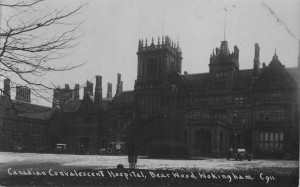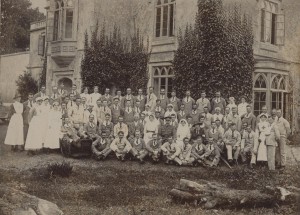The Real Downton Abbey(s)
Forgotten Landscapes of Calling
The popularity of the PBS series Downton Abbey has been much discussed by historians and critics. Despite the criticisms, the audience remains eager for the next episode, engaging with others about the latest plots and subplots. As the second series has moved into the experiences of the Great War, at home and overseas, it is conspicuous how much interest has been created in the history of 1914 – 1918. Little known subjects have been brought into the lives of the Downton audience creating discussion and banter amongst fans. This new audience has rarely considered the ramifications of the Great War outside of their own family connections. However, they have created interest and debate within the study of the war’s affects on populations; dialogue necessary for all of us to come to an informed understanding of that war to end all wars.
The number of British and Empire wounded in the First World War was large, in excess of 2,000,000 men and women. For Canadian forces, the wounded, and those who suffered gas exposure numbered 138,166 individuals. Accidental injuries, disease and other illnesses increased that number, and together had the potential to overwhelm the medical facilities and their staff. However, these facilities were soon augmented by the conversion of several buildings, ranging from schools to hotels, stately homes and royal residences into temporary military hospitals.
Downton Abbey is filmed on location at Highclere Castle which in September 1914 was transformed from a residence into a Great War convalescent hospital by Alimina Herbert, the 5th Countess of Carnarvon. The stately home remained a hospital until 1922. A generation later, during the Second World War, Highclere was once again transformed into a home for child evacuees escaping the terror of the Blitz.

Canadian Convalescent Hospital, Bear Wood, Wokingham, England. Home of the Walter family, original proprietors of “The Times” newspaper.
In Canada, returning soldiers convalesced in temporary hospitals at similarly converted buildings such as the Qualicum Beach Hotel or in Victoria at Craigdarroch Castle, the former Dunsmuir mansion. In these places, here and elsewhere across Canada, the wounded, gassed, sick and injured were cared for by trained medical staff and volunteers. They were near to home on Canadian soil, yet after all they had endured, some succumbed to their traumas and their gravesides can be found in local cemeteries.
It is these non-fictional Downton Abbeys whose stories linger in the pages of history that are often overshadowed by greater events and places of the day. Many of these homes and buildings remain with us sitting upon forgotten landscapes of calling, and where from within the halls and wards the voices of the Great War may still be heard.


Comments